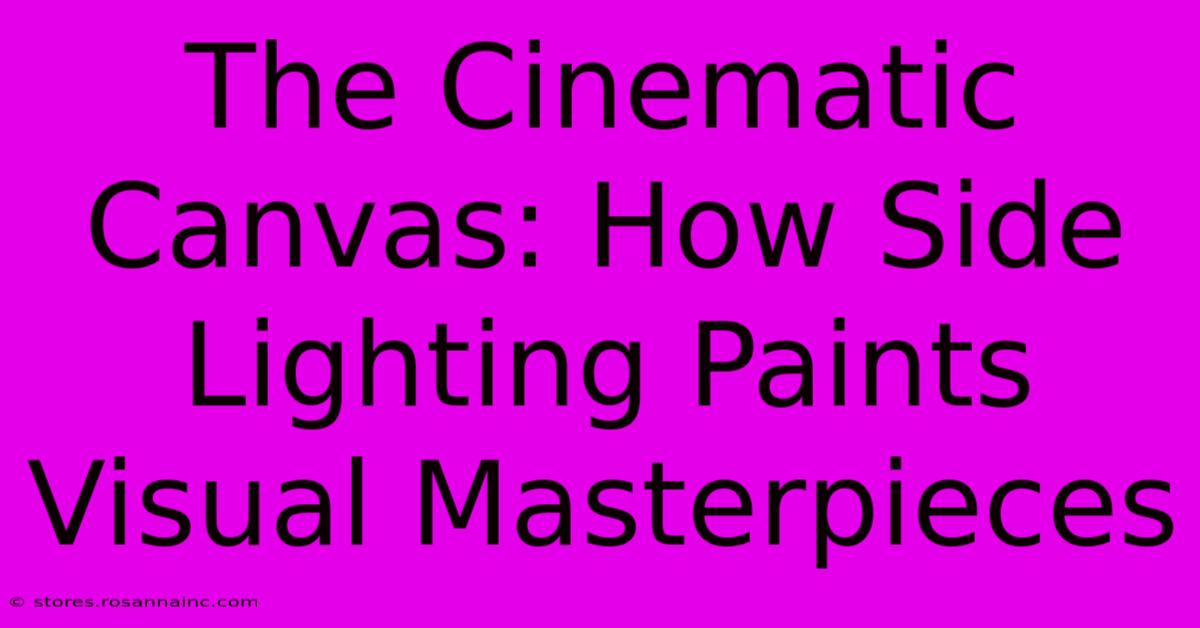The Cinematic Canvas: How Side Lighting Paints Visual Masterpieces

Table of Contents
The Cinematic Canvas: How Side Lighting Paints Visual Masterpieces
Side lighting. It's not just a technical term; it's a powerful storytelling tool in filmmaking, capable of transforming a mundane scene into a visually arresting masterpiece. This technique, often overlooked in favor of its more prominent cousins like front and back lighting, possesses a unique ability to sculpt form, create drama, and evoke emotion in ways few other lighting styles can match. This article delves into the artistry of side lighting, exploring its nuances, applications, and the magic it brings to the cinematic canvas.
Understanding the Power of Side Lighting
Unlike front lighting, which evenly illuminates a subject, side lighting strikes from the side, dramatically highlighting textures, contours, and creating striking shadows. This interplay of light and shadow is what gives side lighting its unique power. It's a technique that favors depth and dimension, turning two-dimensional characters and settings into three-dimensional experiences for the viewer.
Sculpting Form and Defining Character
Side lighting is a master sculptor. By strategically placing the light source, filmmakers can emphasize the lines of a face, the curves of a body, or the rugged texture of a landscape. This creates a sense of realism and physicality, breathing life into the characters and environments. Consider the dramatic effect of side lighting on a weathered face – the shadows accentuate the wrinkles, telling a silent story of hardship and experience.
Creating Atmosphere and Mood
The mood a scene conveys is intrinsically linked to its lighting. Side lighting is particularly adept at establishing atmosphere, ranging from suspenseful mystery to romantic intimacy. A stark side light can heighten tension, casting long, ominous shadows that amplify the feeling of unease. Conversely, a softer side light can create a sense of warmth and intimacy, highlighting the connection between characters.
Mastering the Art of Side Lighting: Techniques and Considerations
The effectiveness of side lighting depends greatly on several factors:
Light Source and Quality
The type of light source significantly impacts the final look. Hard light sources, like the sun or a spotlight, create sharp, defined shadows, ideal for dramatic scenes. Softer light sources, such as diffused daylight or softboxes, produce gentler shadows, perfect for creating a more subtle and romantic atmosphere.
Angle and Intensity
The angle of the light source in relation to the subject determines the length and intensity of the shadows. A low angle side light will cast long, dramatic shadows, while a higher angle will produce shorter, less pronounced shadows. Adjusting the intensity of the light allows filmmakers to control the contrast between light and shadow, fine-tuning the overall mood and impact.
Working with Fill Light
Often, side lighting is used in conjunction with fill light, a softer light source positioned opposite the main light. Fill light softens the shadows created by the side light, preventing them from becoming overly harsh or obscuring details. The balance between side light and fill light is crucial in achieving the desired visual effect.
Examples of Side Lighting in Cinematic Masterpieces
Numerous iconic films demonstrate the power of side lighting. Consider the chiaroscuro effect often used in film noir, where stark contrasts between light and shadow create a sense of suspense and moral ambiguity. Many scenes in classic Hollywood films utilized side lighting to highlight the emotional states of characters, adding depth and complexity to their performances.
Conclusion: The Enduring Power of a Cinematic Classic
Side lighting is more than just a technical element; it's a vital component of cinematic storytelling. Its ability to sculpt form, create atmosphere, and evoke emotion makes it an indispensable tool for filmmakers seeking to create visually stunning and emotionally resonant works. By understanding its nuances and mastering its techniques, filmmakers can unlock its potential and elevate their cinematic creations to new heights. The next time you watch a film, pay attention to the lighting – you might be surprised at the storytelling power of a strategically placed side light.

Thank you for visiting our website wich cover about The Cinematic Canvas: How Side Lighting Paints Visual Masterpieces. We hope the information provided has been useful to you. Feel free to contact us if you have any questions or need further assistance. See you next time and dont miss to bookmark.
Featured Posts
-
The Dark Art Of Persuasion Uncovering The Decision Labs Tactics
Feb 05, 2025
-
Fridge Envy Retro Refrigerators That Will Make Your Kitchen The Coolest Room In The House
Feb 05, 2025
-
Work Connect And Thrive The Future Of Coworking Space In Dos Lagos Post Corona
Feb 05, 2025
-
Step Inside The Enchanted World Of Beatrix Potter A Digital Tour Of The Morgan Library Exhibit
Feb 05, 2025
-
Sticky Note Revolution Uncover Hidden Features For Maximum Efficiency
Feb 05, 2025
